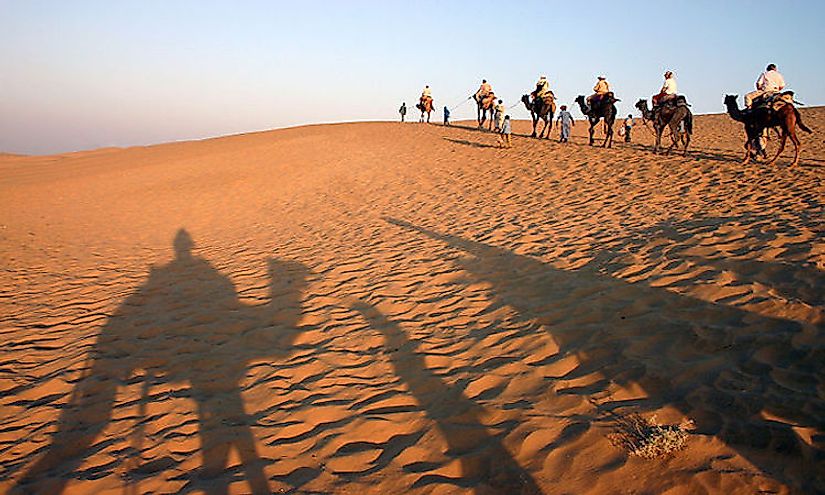Ecological Regions Of Pakistan

Pakistan is a land of high mountains, fertile river valleys, and inhospitable deserts. Situated in South Asia, Pakistan’s ecoregions are home to a wide range of flora and fauna. The Indus Valley ecoregion is the only one that lies entirely in Pakistan while the rest are shared with its neighbors such as India and Nepal.
Ecological Regions Of Pakistan
Himalayan Subtropical Pine Forests
The Himalayan subtropical pine forests ecoregion in Pakistan is classified under the Tropical and Subtropical Coniferous Forests Biome. This ecoregion stretches for about 3,000 km across the Himalayas through Pakistan, India, Nepal, and Bhutan. The dominant pine species is the chir pine ( Pinux roxburghii). The trees in this ecoregion are widely spaced, and fire is a common occurrence in the forests. The burnt slopes in the region are home to abundant grass species such as Imperata cylindrica and Arundinella setosa and shrub species including Rubus and Berberis.
The region is divided into the eastern and the western part of the Kali Gandaki river valley. The eastern part receives more rainfall from monsoon winds from the Bay of Bengal. Fauna in the region do not exhibit a high level of endemism and includes 120 mammal species such as the barking deer, goral, and yellow-throated marten. The ecoregion has been severely degraded through agriculture and deforestation.
Indus Valley Desert
The Indus Valley Desert ecoregion is classified in the Deserts and xeric shrublands Biome. The ecoregion lies in the Indus Valley in Pakistan. The desert is almost inhospitable with annual rainfall ranging a mere 640 to 760 mm. Temperatures recorded in the summer are over 45 degrees Celsius. Shrubs are the most common vegetation, with the most common species being the Prosopis.
32 mammal species have been identified in the region including caracal, Indian leopard, hyena, and Indian wolf. The ecoregion boasts 190 bird species, although none is endemic to the ecoregion. The ecoregion receives less human influence than other ecoregions due to the extreme conditions. Hunting of the mammal species is, however, a major threat.
Indus River-Delta- Arabian Sea Mangroves
The Indus River-Delta-Arabian Sea mangroves ecoregion is classified in the Mangrove Biome. This mangrove ecoregion lies on the Arabian Sea coastline of the Sindh Province in Pakistan. Rainfall in the region averages between 100 and 500 mm in the months of July to September. Summer temperatures recorded are as high as 50 degrees Celsius.
Mangrove trees are the dominant flora, with the common species being the gray mangroves alongside red, black, and Indian mangroves. The mangroves support a rich undergrowth of saplings. The mangroves are an important breeding ground for fish and crustaceans. The ecoregion is also a significant avifauna migration point, and waterbirds such as flamingos and pelicans inhabit the region. Extensive irrigation, agriculture, human encroachment and pollution have been identified as major threats to the ecoregion’s sustainability.
Thar Desert
The Thar Desert ecoregion is classified in the Deserts and xeric shrublands Biome. The ecoregion lies in the Thar Desert, found both in Pakistan and India. Little rainfall is recorded from July to September, ranging between 100 to 500 mm. Sand dunes, rock forms, and salt-lake bottoms are some of the landforms found in the region. Scrub species such as Acacia Calligonum polygonoides and Crotalaria and grasses such as Eleusine, Eragrostis, Panicum, and Cyperus are common vegetation in the region.
Several mammal species have adapted to the extreme conditions including the desert fox, the endangered blackbuck, caracal, and the Indian wild ass. 141 bird species have been identified in the region including the great Indian bustard, tawny eagle, and laggar Falcon.
The desert is densely populated and overgrazing and the introduction of alien species have been identified as some of the threats to the ecoregion. The Nara Desert Wildlife Sanctuary and the Rann of Kutch Wildlife Sanctuary are some of the conservation reserves in the region.
Other Ecoregions In The Country
Other ecoregions in Pakistan are: Baluchistan xeric woodlands; East Afghan Montane conifer forests; Karakoram-West Tibetan Plateau alpine steppe; Kuhrud-Kohbanan Mountains forest steppe; Northwestern Himalayan alpine shrub and meadows; Rann of Kutch seasonal salt marsh; Registan-North Pakistan sandy desert; Tian Shan montane steppe and meadows; Western Himalayan broadleaf forests and Western Himalayan subalpine conifer forests. Pakistan, being a developing nation, is yet to actually curb environmental threats such as industrial pollution, rapid deforestation, and poaching.
Ecological Regions Of Pakistan
| Ecological Regions of Pakistan | Biome |
| Baluchistan xeric woodlands | Deserts and xeric shrublands |
| East Afghan montane conifer forests | Temperate coniferous forests |
| Himalayan subtropical pine forests | Tropical and subtropical coniferous forests |
| Indus River Delta-Arabian Sea mangroves | Mangrove |
| Indus Valley desert | Deserts and xeric shrublands |
| Karakoram-West Tibetan Plateau alpine steppe | Montane grasslands and shrublands |
| Kuhrud-Kohbanan Mountains forest steppe | Montane grasslands and shrublands |
| Northwestern Himalayan alpine shrub and meadows | Montane grasslands and shrublands |
| Rann of Kutch seasonal salt marsh | Flooded grasslands and savannas |
| Registan-North Pakistan sandy desert | Deserts and xeric shrublands |
| Thar desert | Deserts and xeric shrublands |
| Tian Shan montane steppe and meadows | Montane grasslands and shrublands |
| Western Himalayan broadleaf forests | Temperate broadleaf and mixed forests |
| Western Himalayan subalpine conifer forests | Temperate coniferous forests |











